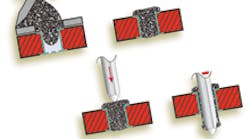Through-Hole Reflow Assembly Process Pioneered by Wieland Electric Strengthens Connections to Printed-Circuit Boards
| Access our Reader Service Web site to quickly find and request information on products and services found in the pages of Machine Design. www.machinedesign.com/rsc |
Through-hole reflow (THR) is a recently developed method of attaching components to printed-circuit boards built with solder-reflow processing. In fact, THR and surface-mount devices (SMD) can be handled at the same time and on the same equipment. This could make wave soldering obsolete and save manufacturers up to 40% on the cost of connecting components to circuit boards.
One company pioneering this new process is Wieland Electric GmbH, a German firm with U.S. headquarters in Burgaw, N.C. (www.wieland.com). They say THR makes strong connections to PC boards, letting electrical components better withstand mechanical loads. THR has been shown to create bonds much stronger than those made using surface-mount technology (SMT). This means THR components, particularly terminal blocks and connectors, can withstand the mechanical forces required during termination and header-and-plug-mating processes. Components can be delivered in trays or tape and reel, so they are suitable for pick-and-place automation as well.
Wieland Electric offers THR connectors in 3.5, 3.81, 5.0, and 5.08-mm pitches for both two-piece connectors and one-piece terminal blocks.
Edited by Stephen J. Mraz
